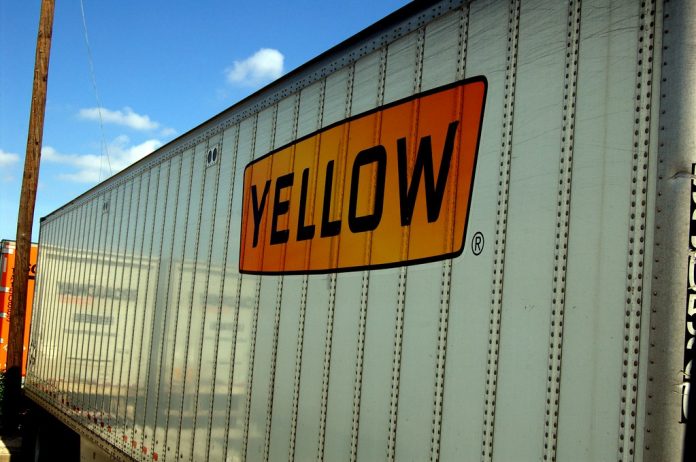Teamsters union sacrifices 30,000 Yellow Freight workers by refusing to negotiate a new contract with the company. (Commentary)
by Rachel Greszler
The company’s closure follows on the heels of negotiations with the Teamsters union, which represents 22,000 members of Yellow’s workforce.
While there are undoubtedly many factors that contributed to Yellow’s closure, its forced dealings with Teamsters were central among them.
Unions are best known for negotiating higher compensation and giving workers representation with management. But unions actually have a say in—and often contractual control over—all things worker-related, meaning they can effectively usurp a company’s management.
1. Union control is invasive. A key reason Yellow was said to be closing its doors is that the union was refusing Yellow’s restructuring and modernization efforts.
Part of that restructuring would have included efficiency savings by enabling an additional 600 utility truck drivers to also sometimes perform dock work, but the union controls what tasks workers are allowed to perform, and Teamsters President Sean O’Brien asserted that this restructuring “would have decimated thousands of Teamsters jobs.”
Instead, the union’s refusal to allow company management to do what it felt necessary to save the business contributed to the decimation of 22,000 Teamsters jobs.
2. Unions stifle competition and innovation. In particular, unionization across industries hurts competition because it prevents companies from innovating and coming up with new ways of operating that can benefit workers and customers alike.
Yellow’s attempt to reduce idle time by having workers perform other tasks was one example of an efficiency that the union prevented.
Yellow had likely also considered automating some tasks (like the dock work that the union didn’t want truckers to have to do), but unions adamantly oppose automation, on the flawed assumption that it will cost jobs. (It’s actually been a historic driver of job creation.)
That’s a main reason, for example, that three California ports rank in the bottom 3% of ports worldwide based on efficiency—because the unions prevent them from automating.
By tying the hands of companies like Yellow to make changes that could have improved its efficiency, unions can drive companies out of business. And that hurts more than just the workers who lose their jobs. As a lower-cost carrier that provided service to major big-box retailers, such as Walmart and Home Depot, Yellow’s absence will almost certainly result in higher prices for consumers.
3. Unions have one voice. Yellow had 22,000 unionized truckers working for the company, but at the end of the day, Teamsters chief O’Brien had the final say. In defending his hard stance against allowing Yellow to take the steps management felt necessary to save the company, O’Brien said, “Sometimes a bad job isn’t worth it anymore.” But it wasn’t O’Brien’s place to say whether those jobs were “worth it” or not for 30,000 Yellow employees and their families.
Clearly, Teamsters’ leadership didn’t think that 22,000 unionized jobs were worth what it could cost union executives in power and influence.
But what about the actual workers themselves? Undoubtedly, many of them liked their jobs, and considering that 30,000 people were still choosing to work for the company, more than a few thought their jobs were “worth it.”
The problem with unions is that their one-voice representation can actually silence a lot of workers—even an entire company’s workforce. Not only do workers at unionized workplaces have no ability to negotiate directly with their employer, but in roughly half of the states that force workers to pay the union as a condition of employment, workers can be forced to pay for union representation that they don’t want and that could hurt them.
In defending Teamsters’ hard-line stance against negotiating with Yellow, O’Brien said, “Yellow has historically proven that it could not manage itself despite billions of dollars in worker concessions and hundreds of millions in bailout funding from the federal government.” O’Brien was referring to a $700 million loan Yellow received from COVID-19-related spending, for which the federal government received a 30 percent stake in the company.
O’Brien did not mention that after decades of gross mismanagement (and potential outright criminal activity), the Central State Teamsters’ union pension fund just received a $35.8 billion taxpayer bailout. And despite that no-repayment-required direct deposit into Teamsters’ pension plan, it’s still likely to be insolvent within 30 years.
Labor unions have played an important role in U.S. history, but for many reasons, they’ve been declining in recent decades and reached an all-time low in 2022. Yet, workers’ desires for upward mobility and increasing flexibility show that workers’ voices are as important today as they ever have been.
To help elevate more workers’ voices without silencing others or driving companies out of business, workers, employers, and policymakers should look to choice-based, voluntary organization models.
In the case of Yellow, that would have allowed workers who felt strongly about the conditions Teamsters was demanding to remain in union-conforming roles, while other workers who were willing to try new roles or accept alternative compensation structures (such as higher pay and lower pensions) could do so.
Originally published by The Daily Signal. Republished with permission.
For more Budget & Tax News.











